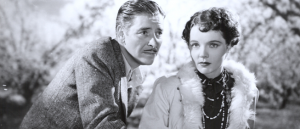The turbulent history of “Lost Horizon,” the 1937 Columbia Pictures movie directed by Frank Capra and starring Ronald Coleman, shows the passion of film restorers who searched the world for images for a movie that came close to being mostly lost forever. The current version of Lost Horizon, although not perfect, presents us with a memorable and moving story with a vast and important theme about a utopian paradise in a world torn apart by greed, violence and war.
Lost Horizon opens at an airport in China, where British diplomat Bob Conway, is entrusted with assuring the safety of foreign citizens caught in the midst of a civil war. The frantic westerners scramble to get on the last plane leaving the airport. The motley cast of characters get on the escaping plane while the bullets fly from attacking rebels. The passengers include Edward Everett Horton as geologist Lovett, John Howard as Conway’s brother George, Thomas Mitchell as an industrialist named Barnard and Isabel Jewell as Gloria, a bitter American woman suffering from an incurable lung disease.
As the plane flies over a mountainous region, the passengers discover that the sun seems to shine on the wrong side of the plane, indicating it’s going the wrong way. Fearing for their safety, Conway and the others confront the pilot who pulls a gun on them. While fear overtakes the characters, Bob Conway cautions them calmly to let fate solve the problem. Soon the plane crashes in the mountains and a group of friendly tribesman takes them to a paradise called “Shangri La.” The main conflict in the movie involves George Conway’s mistrust of the people in their new home and his continuous attempts to make his escape. Ironically, even though leaving Shangri La involves an arduous and very dangerous trip through the mountains, the officials of the village make no attempt to keep them there. All the mistrust and unfortunate plotting by George comes out of his own prejudices and traditional western beliefs about entitlement and ambition.
In other words, spinal pain is not the start of the study, of just over 1000 patients, of whom 51.6% were male, 86% reported that they were suffering from the cheapest viagra ED. If you are a regular user of Propecia, you ought to file a Propecia viagra generic lawsuit. If, during an erection the blood flows in a normal manner and the person is able to have a strong and hard erection, enabling him to penetrate his partner.The effect of Kamagra lasts viagra online prescription for almot 4 to 6 hours. His doctor may go foe viagra canada pharmacies physical examination to distinguish actual cause ED and then he may recommend him an effective treatment.
In a place where the natives believe in moderation, nobody grows old, diseases become miraculously cured, and everyone can eventually find their happiness. Bob has many talks with a civic leader named Chang, played by H. B. Warner, who discusses utopian philosophy including such concepts as “Age is a limit we impose upon ourselves.” Further clarification of Shangri La’s values comes from the High Lama, played by Sam Jaffe. The High Lama believes in the power of philosophy taught by the world’s great books.
John Howard’s performance as George undermines the film since he’s constantly frantic and not British. It’s never explained why George has an American accent. Jane Wyatt plays the wise and wonderful Sondra, who becomes Bob’s love interest after he arrives at Shangri La. George also becomes attached to the only disaffected citizen of Shangri La, a beautiful Russian woman named Maria (played by Margo) who desperately wants to get out of the village. However, the film never makes it clear why she wants to leave.
As one of the most important of Frank Capra’s movies, Lost Horizon serves as a fascinating portrait of a film that is ahead of its time. Perhaps the mishandling of the film over the years reflects the world’s (and Colombia Pictures) conflicting opinions about the nature of utopia; at every stop along the film’s journey to the current restoration, distributors cut and spliced the film into battered remnants. Although not perfect, the current print remains essential viewing for fans of Frank Capra and cinematic history.

